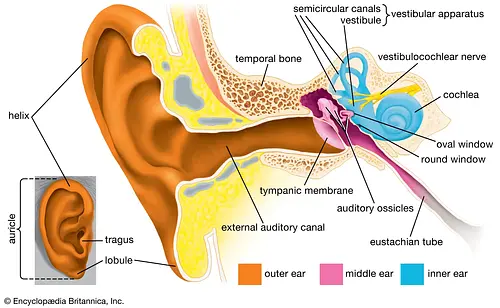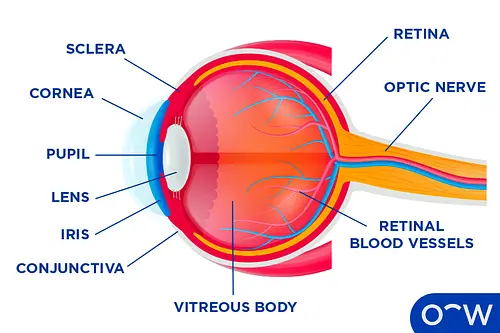Central Nervous System (CNS)
jjay / Jeremy's Nervous System
Jeremy's Nervous System
A concise guide to the human nervous system, covering its structure, function, and key components like the auditory, visual, and motor systems.
Nervous System Overview
Divisions of the Nervous System
|
|
Brain and spinal cord; responsible for processing and coordinating information. |
|
Peripheral Nervous System (PNS) |
Nerves outside the CNS; connects the CNS to the limbs and organs, serving as a communication relay. |
|
Autonomic Nervous System (ANS) |
Regulates involuntary functions (heart rate, digestion, etc.). Divided into sympathetic and parasympathetic branches. |
|
Sympathetic Nervous System |
‘Fight or flight’ response; prepares the body for action. |
|
Parasympathetic Nervous System |
‘Rest and digest’; conserves energy and promotes relaxation. |
Cell Communication
|
Indirect |
Gap Junctions Transient linkup |
|
Indirect |
paracrine secretion neurotransmitter secretion |
|
Endocrine vs nervous signaling |
Endocrine act through hormones controlling process that rely on duration rather than speed Nervous acts through electrical signals for rapid responses |
|
Sympathetic vs Parasympathetic |
Sympathetic releases norepinephrine to Adrenergic receptors Parasympathetic releases ACh to cholinergic receptors |
The Auditory System
Components of the Ear
|
External Ear |
Pinna, external auditory meatus, tympanic membrane |
|
Middle Ear |
Tympanic membrane, ossicles, oval window |
|
Inner Ear |
oval window, cochlea, vestibular apparatus, round window |
Simplified Auditory Pathway
|
Key Concepts
|
Auditory Receptors |
Hair cells located in the cochlea. These hairs are bent when the basilar membrane is deflected which opens mechanically gated channels, leading to ion movements resulting in a receptor potential |
|
Pitch |
depends on the region of the basilar membrane that vibrates. Think “where” |
|
Loudness |
depends on the amplitude of vibration of the basilar membrane. Think “How Much” |
The Visual System
Components of the Eye
|
Cornea |
Transparent outer layer that refracts light. |
|
Lens |
Focuses light onto the retina. |
|
Retina |
Layer of photoreceptor cells (rods and cones) that transduce light into electrical signals. |
|
Fovea |
Central focal point in the retina, responsible for sharp central vision. |
|
Optic Disk |
The ‘blind spot’ in the retina where the optic nerve exits; lacks photoreceptors. |
|
Optic Nerve |
Transmits electrical signals from the retina to the brain. |
Visual Pathway
|
Key Concepts
|
Rods |
Photoreceptors sensitive to dim light |
|
Cones |
Photoreceptors sensitive to bright light |
|
Fovea |
Central region of the retina with a high concentration of cones; responsible for high-acuity vision. |
The Motor System
Components of the Motor System
|
Cerebral Cortex |
Planning, initiating, and executing voluntary movements; primary motor cortex, premotor cortex, supplementary motor area. |
|
Basal Ganglia |
Involved in motor control, motor learning, executive functions and behaviors, and emotions. |
|
Cerebellum |
Coordinates movement and maintains balance. |
|
Brainstem |
Relays motor signals from the cerebral cortex and cerebellum to the spinal cord; controls basic motor functions (e.g., posture). |
Motor Pathways
|
Key Concepts
|
Motor Neuron |
Nerve cell that directly innervates and controls muscle fibers axons of motor neurons originate in the CNS and end on skeletal muscle |
|
Neuromuscular Junction |
Chemically links neurons and skeletal muscle fibers each muscle cell has only 1 Muscle fiber: single, long, and cylindrical muscle cell Terminal Button: enlarged knoblike structure at the end of axon terminal branches |
|
Spinal Cord |
each segment contains motor neurons that project to same side skeletal muscles each segment also contains motor neurons that project to skeletal muscles via ventral roots |
Neuromuscular Signaling Disruptions
|
Curare |
poison that binds strongly to nicotinic ACh receptors ACh therefore can not bind to receptors thus resulting in no muscle contractions |
|
Myasthenia |
autoimmune disease where antibodies attack nicotinic ACh receptors causes muscle weakness commonly around facial expression muscles can be treated with ACh-esterase inhibitors which reduce rate of ACh degradation |
|
Tetanus |
wound becomes contaminated with Clostridium Tetani toxins block release of inhibitory neurotransmitter causes stiffness and rigidity |
|
Botulism |
ingesting spores from Clostridium botulinum bacteria inhibits release of excitatory neurotransmitter causes muscle weakness |


